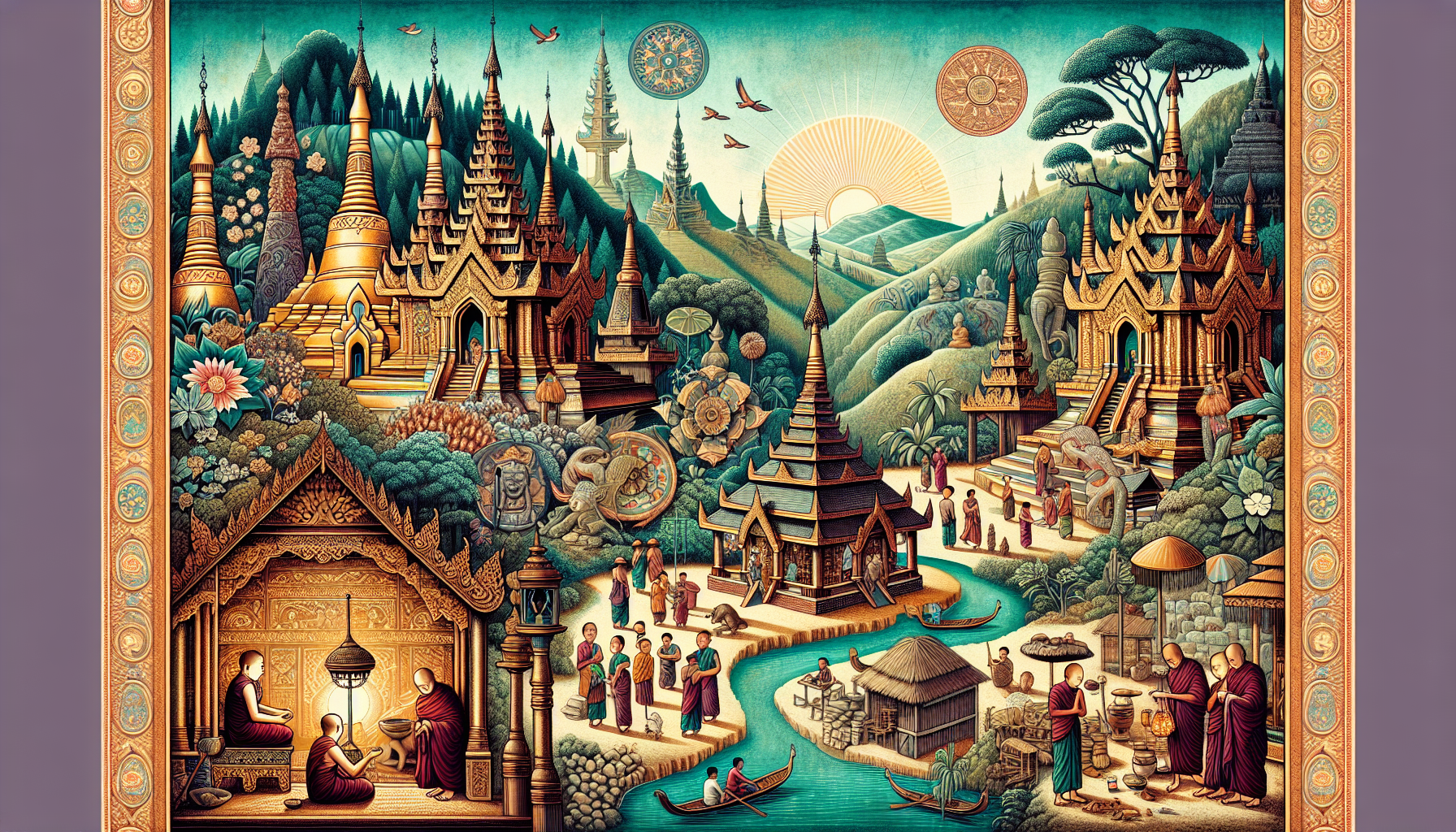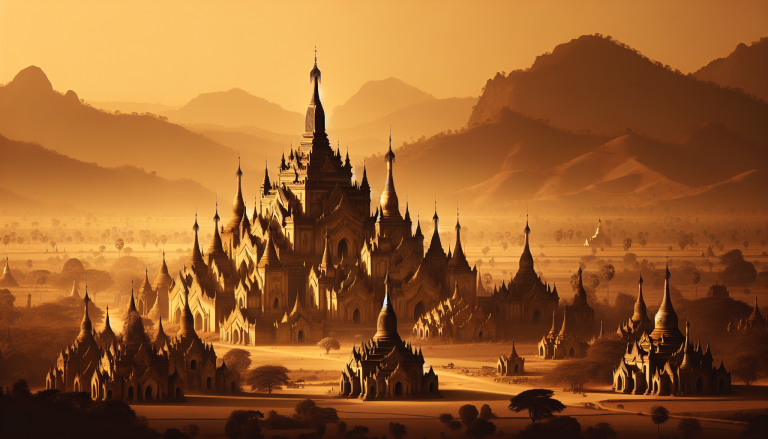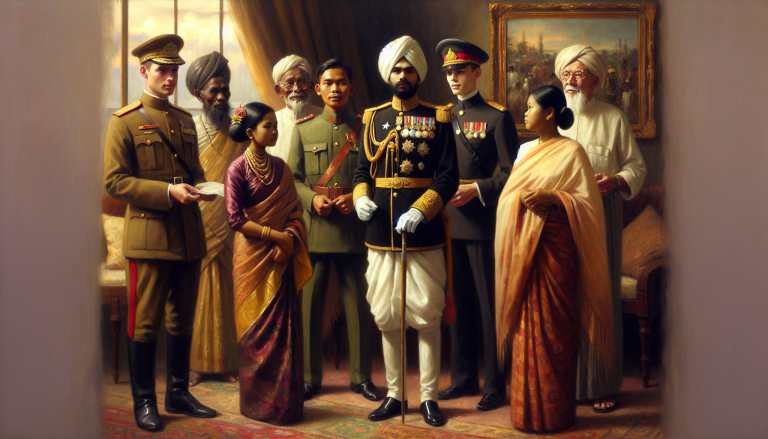Journey Through Time: The Wonders of Myanmars Ancient Culture
Explore Myanmar’s ancient culture! Dive into kingdoms, architecture, and Buddhism’s legacy. Discover history anew!

Ancient Myanmar Kingdoms
Embark on a journey to uncover the wonders of Myanmar’s ancient culture, starting with the earliest kingdoms that laid the foundation for this fascinating civilization.
Tagaung Kingdom Origins
The origins of Myanmar’s ancient kingdoms can be traced back to Tagaung, located north of modern-day Mandalay. According to legend, the Tagaung Kingdom was founded in 850 BCE by Abhiyaza, a descendant of Maha Sammata, who is considered to be the world’s first monarch (Frontier Myanmar). This kingdom is regarded as the birthplace of Myanmar’s civilization and played a significant role in shaping the region’s cultural and political landscape.
Pyu City-States and Theravada Buddhism
During the first millennium CE, the Pyu people established themselves as one of the dominant groups in Myanmar. They founded several prominent city-states, including Tagaung and Bagan. By the fourth century CE, the Pyu had adopted Theravada Buddhism, which significantly influenced their culture and religious practices.
| Pyu City-State | Significant Features |
|---|---|
| Tagaung | Early settlement, foundational Pyu city |
| Bagan | Future epicenter of Myanmar culture |
Discover more about the impact of Buddhism on Myanmar by exploring Theravada Buddhism in Myanmar.
Influence of Mon People in Myanmar
The Mon people, who migrated from the east, also played a crucial role in Myanmar’s ancient history. They settled in the Ayeyarwady Delta and the Malay Peninsula, establishing the Thaton Kingdom. This kingdom is believed to be Myanmar’s first Theravada Buddhist state, further cementing the region’s devotion to the religion (Frontier Myanmar).
| Mon Settlement Area | Notable Kingdom |
|---|---|
| Ayeyarwady Delta | Thaton Kingdom |
| Malay Peninsula | Expansion of Mon influence |
To delve deeper into Myanmar’s rich history and heritage, check out our extensive Myanmar History and Culture resources.
These early kingdoms and their inhabitants laid the groundwork for Myanmar’s diverse and vibrant culture. Whether you’re interested in ancient ruins or historical documents, Myanmar has a wealth of historical sites and artifacts waiting to be explored. Continue your historical journey by exploring more about Myanmar’s ancient civilizations and their incredible achievements.
Architectural Wonders of Myanmar
Myanmar’s ancient culture reveals itself through its magnificent architectural heritage. Travelers with a passion for history and culture are in for a treat exploring Myanmar’s ancient architectural marvels.
Bagan Empire and Mon Influence
The Bagan Empire stands out as a significant highlight when you think of Myanmar’s ancient culture. The Bagan Empire, which flourished between the 9th and 13th centuries CE, is known for its impressive array of temples and stupas that dot the plains of Bagan. The sheer number of structures—over 2,000 still standing today—speaks to the region’s historical and cultural importance.
The Mon people, who migrated into lower Myanmar and established themselves well before the Bagan period, had a considerable influence on Bagan’s architectural style. Their knowledge of Theravada Buddhism significantly impacted the design and purpose of Bagan’s religious edifices.
One of the most notable examples is the Ananda Temple, a stunning structure that showcases intricate carvings and a distinct Mon style. These architectural wonders serve not only as religious sanctuaries but also as cultural landmarks that provide insight into the Bagan Kingdom history.
| Architectural Feature | Influence | Period |
|---|---|---|
| Ananda Temple | Mon | 11th Century CE |
| Shwezigon Pagoda | Theravada Buddhism | 11th Century CE |
| Sulamani Temple | Mon | 12th Century CE |
Sri Ksetra: Pyu Cultural Hub
Sri Ksetra, a prominent Pyu settlement, offers another glimpse into Myanmar’s historic architecture. Situated along the Irrawaddy River at present-day Hmawza, Sri Ksetra was an influential cultural and trade hub during the first millennium CE.
Sri Ksetra is notable for its monumental brick walls, which enclose 1,857 hectares, making it the largest Southeast Asian city before Angkor. The site served as a cultural bridge between China and India, introducing Buddhism and facilitating the coexistence of Buddhist and Hindu practices.
The city is an archaeological treasure trove, with numerous stupas and temples showcasing the artistic legacy of the Pyu people. Buddhism’s spread from India into Myanmar significantly influenced the architecture and artistic production at Sri Ksetra (Myanmar ancient architecture).
| Site | Feature | Area (hectares) |
|---|---|---|
| Sri Ksetra | Monumental City Walls | 1,857 |
| Bawbawgyi Stupa | Ancient Stupa | N/A |
| East Zegu Temple | Buddhist Temple | N/A |
Breathtaking Myanmar Artistry
Myanmar’s artistic heritage is reflected in its architecture, with exquisite detailing and craftsmanship evident throughout its ancient structures. The fusion of indigenous styles with Buddhist and Hindu influences creates a unique aesthetic that is both spiritually meaningful and artistically impressive.
The Pyu at Sri Ksetra left behind a remarkable artistic legacy, with Chinese pilgrims such as Hsuan-tsang and I-tsing documenting the site as a Buddhist country (Myanmar archaeological discoveries).
In addition to religious structures, other forms of art, including intricate carvings, statues, and mural paintings, adorn the temples and stupas, offering a visual journey into Myanmar’s rich history.
For more on the artistry of ancient Myanmar, explore our resources on myanmar ancient crafts.
By exploring Myanmar’s architectural wonders, you can appreciate the artistry and cultural significance that these ancient structures hold. Each site offers a different facet of Myanmar’s history, making it a must-visit for any traveler interested in ancient civilizations and historical architecture.
Legacy of Burmese Buddhism
The rich history of Buddhism in Myanmar highlights its pivotal role in shaping the nation’s cultural and spiritual landscape.
Early Spread of Buddhism
Buddhism’s roots in Myanmar trace back to the Pyu city-state of Sri Ksetra, where the oldest surviving Buddhist texts in Pāli, dating to the mid-5th to mid-6th century, were discovered on solid gold plaques (Wikipedia). The script closely resembles that of South India’s Andhra-Kuntala-Pallava region, suggesting that Theravāda Buddhism arrived in Burma from this area.
You can even visit Sri Ksetra to witness these ancient relics, a testament to the early spread of Buddhism. Explore more about the ancient myanmar civilizations that adopted and propagated Buddhism.
Transformative Periods in Burmese Buddhism
One of the transformative moments in Burmese Buddhism occurred during the reign of King Anawrahta (1044–1077) of the Bagan Kingdom. After his conquest of the Thaton Kingdom, Anawrahta adopted Theravāda Buddhism and instituted several religious reforms. He invited Theravāda scholars from Sri Lanka and India to enhance the religious framework (Wikipedia).
King Anawrahta’s efforts established Theravāda Buddhism as the state religion and led to the construction of numerous pagodas and monasteries. This period saw the flourishing of religious art and architecture, echoing through myanmar ancient architecture.
Modernization and Preservation Efforts
Burmese Buddhism underwent another significant transformation during the reign of King Mindon Min (1853–1878). King Mindon convened the Fifth Buddhist Council between 1868 and 1871 to edit the Pali canon, resulting in a new edition inscribed on 729 stone tablets at the Kuthodaw Pagoda complex. Mindon also initiated the Sudhammā reforms to standardize and modernize the sangha (monastic community).
Modern efforts to preserve and promote Buddhism include the MaBaTha organization, which aims to protect and advocate for Buddhism amidst contemporary challenges.
For those interested in exploring the present impact and historical evolution of Buddhism in Myanmar, further insights can be found in contemporary buddhist nationalism and modern burmese buddhism.
Table of Major Transformations in Burmese Buddhism
| Time Period | Event | Impact |
|---|---|---|
| Mid-5th to Mid-6th Century | Arrival of Theravāda Buddhism via South India | Establishment of Buddhism in Myanmar |
| 1044–1077 | Reign of King Anawrahta | Adoption of Theravāda Buddhism as state religion |
| 1853–1878 | Reign of King Mindon Min | Modernization and standardization of the sangha |
Dive deeper into the fascinating myanmar history facts to fully appreciate the intricate tapestry of Buddhism’s role in Myanmar’s past and present.
Evolution of Myanmar’s Cultural Landscape
British Colonial Impact
British rule over Burma brought profound social, economic, cultural, and administrative changes that totally transformed the once-agrarian society. The colonizers introduced a centralized administrative system, modern education, and an economic shift towards rice cultivation for export. However, their rule also highlighted the differences among the country’s myriad ethnic groups, leading to a fragmented society.
These divisions persisted even after independence in 1948, causing enduring civil conflicts involving various insurgent groups and central governments. Since then, Myanmar has been one of the least developed nations due to prolonged military rule, from 1962 to 2010 and again from 2021 to the present. For more on this topic, explore our articles on myanmar historical documents and myanmar historical events.
| Period | Major Influence |
|---|---|
| 1824 – 1948 | British Rule: Modernization and Ethnic Fragmentation |
Konbaung Dynasty’s Cultural Integration
The Konbaung Dynasty, the last dynasty before British colonial rule, played a significant role in Myanmar’s cultural integration. This period saw significant internal consolidation and the importation of cultural elements from conquered regions. Art from this time witnessed more Shan and Mon influences, with distinctive characteristics in Buddha statues (Wikipedia).
King Bayinnaung’s conquests brought skilled craftsmen to Burma, introducing finer Burmese lacquerware known as Yun. This era laid the foundation for the rich tapestry of Myanmar’s cultural heritage, which is evident in various forms of art and architecture. For more insights, visit our pages on myanmar ancient art and burmese monarchs.
Contemporary Buddhist Nationalism
In recent years, rising Buddhist nationalism has become more visible in Myanmar. Since the political transition in 2011, there’s been a surge in extreme Buddhist nationalism, anti-Muslim hate speech, and deadly communal violence, notably in Rakhine state but also across the country (Crisis Group).
Groups like the Association for the Protection of Race and Religion (MaBaTha) have gained broad appeal, particularly among nuns and laywomen’s organizations. MaBaTha’s support for community activities offers a sense of belonging and participation, especially for youth with limited opportunities. For more about this socio-religious dynamic, check out our articles on contemporary burmese history and theravada buddhism in myanmar.
| Year | Event |
|---|---|
| 2011 – Now | Rise in Buddhist Nationalism and Ethnic Conflicts |
Understanding these pivotal moments in Myanmar’s history can give you a more nuanced view of its rich cultural landscape. From colonial impacts to contemporary social dynamics, every era has left its mark on the country’s diverse heritage. Explore more on related topics like ancient burmese dynasties and myanmar historical research.






